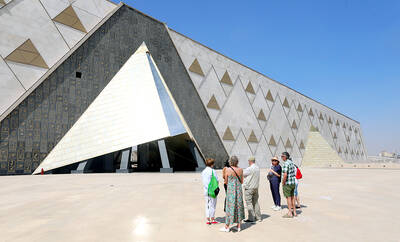An ice bridge which had apparently held a vast Antarctic ice shelf in place during recorded history shattered on Saturday and could herald a wider collapse linked to global warming, a leading scientist said.
“It’s amazing how the ice has ruptured. Two days ago it was intact,” David Vaughan, a glaciologist with the British Antarctic Survey, said of a satellite image of the Wilkins Ice Shelf on the Antarctic Peninsula.
The satellite picture, from the European Space Agency (ESA), showed that a 40km long strip of ice believed to pin the Wilkins Ice Shelf in place had splintered at its narrowest point, which is about 500m wide.
“We’ve waited a long time to see this,” he said.
The Wilkins, now the size of Scotland or Connecticut, is one of 10 shelves to have shrunk or collapsed in recent years on the Antarctic Peninsula, where temperatures have risen in recent decades, apparently because of global warming.
The ESA picture showed a jumble of huge flat-topped icebergs in the sea where the ice bridge had been on Friday, pinning the Wilkins to the coast and running northwest to Charcot Island.
“Charcot Island will be a real island for the first time in history,” Vaughan said.
Vaughan, who landed on the flat-topped ice bridge on the Wilkins in January in a ski-equipped plane with other scientists and reporters, said change in Antarctica was rarely so dramatic.
It was the first — and last — visit to the area.
The loss of the ice bridge, which jutted about 20m out of the water and was almost 100km wide in 1950, may now allow ocean currents to wash away more of the Wilkins shelf.
“My feeling is that we will lose more of the ice, but there will be a remnant to the south,” Vaughan said.
Ice shelves float on the water and are formed by ice spilling off Antarctica. They can be hundreds of meters thick.
Nine other shelves have receded or collapsed around the Antarctic Peninsula in the past 50 years, often abruptly, like the Larsen A in 1995 or the Larsen B in 2002.
Cores of sediment on the seabed indicate that some of these ice shelves had been in place for at least 10,000 years. Vaughan said an ice shelf would take many hundreds of years to form.
In January, the remaining ice bridge had been surrounded by icebergs the size of shopping malls, many of them trapped in sea ice. A few seals were visible lolling on sea ice in the low Antarctic sunshine.
On that visit, Vaughan put up a GPS satellite monitoring device and predicted the ice bridge would break within weeks. The plane left quickly, in case the ice was unstable on a part of the world about to disappear from the map.
Temperatures on the Antarctic Peninsula have risen by up to 3ºC in the past 50 years, the fastest rate of warming in the Southern Hemisphere.
“We believe the warming on the Antarctic Peninsula is related to global climate change, though the links are not entirely clear,” Vaughan said.
Antarctica’s response to warming will go a long way to deciding the pace at which sea levels swell.
About 175 countries have been meeting in Bonn, Germany, since March 29 as part of a push to agree by the end of next year a new UN treaty to combat climate change.
The loss of ice shelves does not affect sea levels — floating ice contracts as it melts and so does not raise ocean levels. But their loss can allow glaciers on land to slide more rapidly towards the sea, adding water to the oceans.
The Wilkins does not have much ice pent up behind it. But bigger ice shelves to the south on the frozen continent, where no major warming has been detected, hold back far more ice.
The news comes hot on the heels of the release of a survey by British and US researchers warning of the perilous state of Antarctic ice shelves and fast melting glaciers.
The new report lays the blame firmly on global warming.

With much pomp and circumstance, Cairo is today to inaugurate the long-awaited Grand Egyptian Museum (GEM), widely presented as the crowning jewel on authorities’ efforts to overhaul the country’s vital tourism industry. With a panoramic view of the Giza pyramids plateau, the museum houses thousands of artifacts spanning more than 5,000 years of Egyptian antiquity at a whopping cost of more than US$1 billion. More than two decades in the making, the ultra-modern museum anticipates 5 million visitors annually, with never-before-seen relics on display. In the run-up to the grand opening, Egyptian media and official statements have hailed the “historic moment,” describing the

‘CHILD PORNOGRAPHY’: The doll on Shein’s Web site measure about 80cm in height, and it was holding a teddy bear in a photo published by a daily newspaper France’s anti-fraud unit on Saturday said it had reported Asian e-commerce giant Shein (希音) for selling what it described as “sex dolls with a childlike appearance.” The French Directorate General for Competition, Consumer Affairs and Fraud Control (DGCCRF) said in a statement that the “description and categorization” of the items on Shein’s Web site “make it difficult to doubt the child pornography nature of the content.” Shortly after the statement, Shein announced that the dolls in question had been withdrawn from its platform and that it had launched an internal inquiry. On its Web site, Le Parisien daily published a

China’s Shenzhou-20 crewed spacecraft has delayed its return mission to Earth after the vessel was possibly hit by tiny bits of space debris, the country’s human spaceflight agency said yesterday, an unusual situation that could disrupt the operation of the country’s space station Tiangong. An impact analysis and risk assessment are underway, the China Manned Space Agency (CMSA) said in a statement, without providing a new schedule for the return mission, which was originally set to land in northern China yesterday. The delay highlights the danger to space travel posed by increasing amounts of debris, such as discarded launch vehicles or vessel

RUBBER STAMP? The latest legislative session was the most productive in the number of bills passed, but critics attributed it to a lack of dissenting voices On their last day at work, Hong Kong’s lawmakers — the first batch chosen under Beijing’s mantra of “patriots administering Hong Kong” — posed for group pictures, celebrating a job well done after four years of opposition-free politics. However, despite their smiles, about one-third of the Legislative Council will not seek another term in next month’s election, with the self-described non-establishment figure Tik Chi-yuen (狄志遠) being among those bowing out. “It used to be that [the legislature] had the benefit of free expression... Now it is more uniform. There are multiple voices, but they are not diverse enough,” Tik said, comparing it